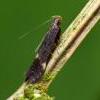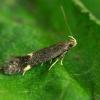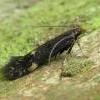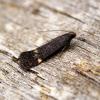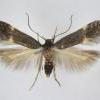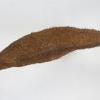35.081 Oxypteryx atrella ([Denis & Schiffermüller], 1775)
Status and Distribution
The genus Eulamprotes is now considered a junior synonym of Oxypteryx.
Widespread but local throughout much of England, becoming local to very local in northern England, Wales, Ireland and Northern Ireland. Not recorded from Scotland, Isle of Man or the Channel Islands.
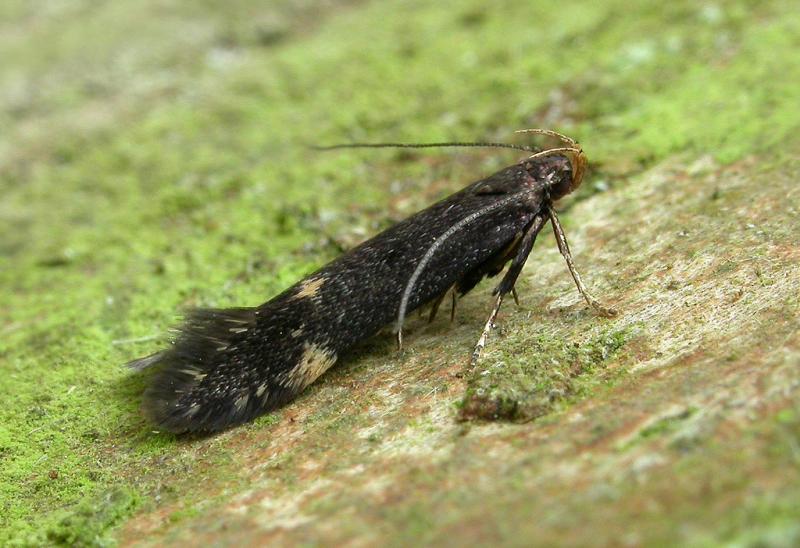
Provisional map
Foodplant and Larval Feeding Signs
Hypericum perforatum (perforate st john’s-wort), see plant distribution map, Hypericum hirsutum (hairy st john’s-wort).
In Europe also found on Hypericum maculatum (imperforate st john’s-wort).
Larval feeding on the terminal leaves of the young plant cause them to droop slightly and then wither. The larva then mines the stem from the tip completing its development as a pupa in a case constructed from part of a leaf which drops to the ground.
Habitat
Rough ground, dry meadows, grassland, open woods, roadsides, downland and stream sides.
Finding the Moth
Larva: feeding on the terminal leaves of the young plant cause them to droop slightly and then wither. The larva then mines the stem from the tip completing its development as a pupa in a case constructed from part of a leaf which drops to the ground in June.
Adult: can sometimes be disturbed from around the foodplant; flies from early evening and comes to light.
Similar Species
Care should be taken when identifying this species particularly if worn.
A few similarly-sized Gelechiid species (see below) have this combination of dark forewing and whitish yellow tornal and costal spots. The colouration of the labial palps are one of the more useful features to aid determination. Outside the main flight period, Oxypteryx immaculatella will need to be considered and dissection may be necessary.
nb - labial palp (lp) segment one is very short (difficult to see) and tucked back below the eye; segment two is broader and extends forward to a position in front of the base of the face; segment three is thin and needle-like curving up in front of the face.
Oxypteryx atrella - lp segments 1, 2 and 3 obviously ochreous with the lower edge in segment 3 narrowly fuscous (blackish brown). Forewing has apical quarter with a purple sheen in fresh specimens.
Oxypteryx immaculatella - lp segment 1 dark fuscous and segment 2 greyish white above and on sides, dark fuscous below. Slightly smaller species with diffuse or absent (particularly if worn) paler forewing markings.
Aproaerema anthyllidella - lp segment 1 purplish-fuscous, segment 2 variable in extent of buffish-white and purplish-fuscous and segment 3 buffish-white with outer edge purplish fuscous. The forewing often has yellowish ochreous scales in the fold (lower central part of the forewing at one-third). This species has a dark cilia line obvious in fresh specimens, absent in Oxypteryx spp.
Aproaerema sangiella - lp segment 1 purplish-fuscous, segment 2 inner surface buffish white, outer surface has a variable mix of darker and lighter scales and segment 3 inner surface buffish white, outer surface purplish fuscous. Generally a larger moth.
Aproaerema albipalpella (rare) - lp segment 2 has white ring at apex. A small species.
Single brooded from late June to the end of August.
Earliest: 6th May 2008 (VC31)
Latest: 19th September 2009 (VC11)
The above and another May record are reported as having been confirmed by dissection. They are however exceptionally early dates and may reflect some unusual climatic/ecological circumstance at the breeding site.

